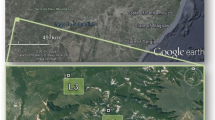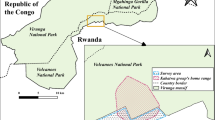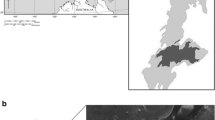Abstract
As human modification of primate habitats expands, overlapping use of resources and conflict between people and primates are becoming more common, particularly at the forest–farm edge where primates feed on crops. Although there is anecdotal evidence that the white-faced capuchin monkey (Cebus imitator) feeds on crops in Panama, to our knowledge farmers’ perceptions of this behavior have not been systematically investigated. We assessed farmers’ perceptions of and attitudes toward crop-feeding by white-faced capuchins by conducting freelisting exercises with 37 farmers and in-depth interviews with 29 farmers in rural communities of Renacimiento District, Chiriquí Province, Panama. We also set up 26 camera traps in five maize fields to capture crop-feeding behavior. Our findings indicate farmers perceived the white-faced capuchin to be one of the main crop feeders causing crop damage. Although two-thirds of the farmers we interviewed said that crop-feeding by white-faced capuchins has decreased over the years, 70% of farmers are still greatly affected by capuchin crop damage. Camera trap data revealed the white-nosed coati to be the most frequent crop feeder; capuchins were identified only in two crop-feeding events. Farmers identified several techniques that they use to deter white-faced capuchins, most of which are currently nonlethal. Farmers expressed sympathy for the capuchins, noting the impact of deforestation on wild food abundance and recognizing that “capuchins need to eat too.” These findings indicate that rural communities in Chiriquí province, Panama may be receptive to conservation messaging that emphasizes human–capuchin coexistence.



Similar content being viewed by others
References
Anand, S., Binoy, V. V., & Radhakrishna, S. (2018). The monkey is not always a god: Attitudinal differences toward crop-raiding macaques and why it matters for conflict mitigation. Ambio, 47, 711–720. https://doi.org/10.1007/s13280-017-1008-5.
Baker, M., & Schutt, A. (2005). Managing monkeys and mangos. In J. Patterson & J. Wallis (Eds.), Commensalism and conflict: The human-primates interface (pp. 445–463). American Society of Primatologists.
Bernard, H. R. (2006). Research methods in anthropology: Qualitative and quantitative approaches. Altamira Press.
Boubli, J., Rylands, A., Farias, I., Alfaro, M., & Lynch Alfaro, J. (2012). Cebus phylogenetic relationships: A preliminary reassessment of the diversity of the untufted capuchin monkeys. American Journal or Primatology, 74, 381–393. https://doi.org/10.1002/ajp.21998.
Chaves, Ó. M., & Bicca-Marques, J. C. (2017). Crop feeding by brown howlers (Alouatta guariba clamitans) in forest fragments: The conservation value of cultivated species. International Journal of Primatology, 38, 263–281. https://doi.org/10.1007/s10764-016-9927-8.
DEC (Dirección de Estadística y Censo, PA) (2001). VI Censo nacional agropecuario. Contraloría General de la República.
Díaz-Pulido, A., & Payán Garrido, E. (2012). Manual de fototrampeo: Una herramienta de investigación para la conservación de la biodiversidad en Colombia. Instituto de Investigación de Recursos Biológicos Alexander von Humboldt.
Dore, K. M. (2017). Navigating the methodological landscape: Ethnographic data expose the nuances of “the monkey problem” in St. Kitts, West Indies. In K. M. Dore, E. P. Riley, & A. Fuentes (Eds.), Ethnoprimatology: A practical guide to research at the human-nonhuman primate interface (pp. 219–231). Cambridge University Press. https://doi.org/10.1017/9781316272466.018.
Dore, K. M., Eller, A. R., & Eller, J. L. (2018). Identify construction and symbolic association in farmer–vervet monkey (Chlorocebus aethiops sabaeus) interconnections in St. Kitts. Folia Primatologica, 89, 63–80. https://doi.org/10.1159/000479064.
Ecoambiente, S. A. (2007). Estudio de impacto ambiental categoría III: Proyecto hidroeléctrico Bajo de Mina. CICSA Panamá S.A.
Estrada, A., Raboy, B. E., & Oliveira, L. C. (2012). Agroecosystems and primate conservation in the tropics: A review. American Journal of Primatology, 74, 696–711. https://doi.org/10.1002/ajp.22033.
Fuentes, A., & Hockings, K. (2010). The ethnoprimatological approach in primatology. American Journal of Primatology, 72, 841–847. https://doi.org/10.1002/ajp.20844.
Fuentes, A., & Wolfe, L. (2002). Primates face to face: The conservation implications of human–nonhuman primate interconnections. Cambridge University Press.
FUNDICCEP/Fundación Natura/FIDECO (2014). Plan de conservación de la subcuenca del río Caisán. GEMAS.
González-Kirchner, J. P., & Sainz de la Maza, M. (1998). Primates hunting by Guaymi Ameriandian in Costa Rica. Human Evolution, 13(1), 15–19. https://doi.org/10.1007/BF02439364.
Hill, C. M. (2000). Conflict of interest between people and baboons: Cropraiding in Uganda. International Journal of Primatology, 21(2), 299–315. https://doi.org/10.1023/A:1005481605637.
Hill, C. M. (2015). Perspectives of “conflict” at the wildlife–agriculture boundary: 10 years on. Human Dimensions of Wildlife. https://doi.org/10.1080/10871209.2015.1004143.
Hill, C., & Webber, A. (2010). Perceptions of nonhuman primates in human–wildlife conflict scenarios. American Journal of Primatology, 72, 919–924. https://doi.org/10.1002/ajp.20845.
Humle, T., & Hill, C. (2016). People-primate interactions: Implications for primate conservation. In S. A. Wich & A. J. Marshall (Eds.), An introduction to primate conservation (pp. 219–240). Oxford University Press. https://doi.org/10.1093/acprof:oso/9780198703389.003.0014.
IADB (Inter-American Development Bank) (2009). LAE no. 6: Estudio preliminar para generar el marco de evaluación de los potenciales impactos acumulativos asociados a los desarrollos hidroeléctricos actualmente concesionados en la cuenca del Río Chiriquí Viejo – Panamá. Informe final – Versión final. https://pdfslide.tips/documents/rio-chiriqui-viejo-estudiopdfaspx.html
INEC (Instituto Nacional de Estadística y Censo, PA) (2011). VII Censo nacional agropecuario. Contraloría General de la República.
Jack, K. M., & Campos, F. A. (2012). Distribution, abundance, and spatial ecology of the critically endangered Ecuadorian capuchin (Cebus albifrons aequatorialis). Tropical Conservation Science, 5(2), 173–191. https://doi.org/10.1177/194008291200500207.
Krief, S., Cibot, M., Bortolamiol, S., Seguya, A., Krief, J. M., & Masi, S. (2014). Wild Chimpanzees on the edge: Nocturnal activities in croplands. PLoS ONE, 9(10). https://doi.org/10.1371/journal.pone.0109925.
Lambert, J. E. (1998). Primate frugivory in Kibale National Park, Uganda, and its implications for human use of forest resources. African Journal of Ecology, 36, 234–240. https://doi.org/10.1046/j.1365-2028.1998.00131.x.
Lee, P. C., & Priston, N. E. (2005). Human attitudes to primates: Perceptions of pets, conflict and consequences for primate conservation. In J. D. Patterson & J. Wallis (Eds.), Commensalism and conflict: The human-primate interface (pp. 2–23). American Society of Primatologists.
Loría, L. I., & Méndez-Carvajal, P. (2017). Uso de hábitat y patrón de actividad del mono cariblanco (Cebus imitator) en un agroecosistema cafetalero en la provincia de Chiriquí, Panamá. Tecnociencia, 19(1), 61–78 https://revistas.up.ac.pa/index.php/tecnociencia/article/view/32.
McKinney, T. (2011). The effects of provisioning and crop-raiding on the diet and foraging activities of human-cmmensal white-faced capuchins (Cebus capucinus). American Journal of Primatology, 73(5), 439–448. https://doi.org/10.1002/ajp.20919.
McKinney, T. (2015). A classification system for describing anthropogenic influence on nonhuman primate populations. American Journal of Primatology, 77(7), 715–726. https://doi.org/10.1002/ajp.22395.
McLennan, M. R., Spagnoletti, N., & Hockings, K. J. (2017). The implications of primate behavioral flexibility for sustainable human–primate coexistence in anthropogenic habitats. International Journal of Primatology, 38, 105–121. https://doi.org/10.1007/s10764-017-9962-0.
Meek, P. D., Ballard, G., Claridge, A., Kays, R., Moseby, K., O’Brien, T., O’Connell, A., Sanderson, J., Swann, D. E., Tobler, M., & Townsend, S. (2014). Recommended guiding principles for reporting on camera trapping research. Biodiversity and Conservation, 23, 2321–2343. https://doi.org/10.1007/s10531-014-0712-8.
Meijaard, E., Buchori, D., Hadiprakarsa, Y., Utami-Atmoko, S. U., Nurcahyo, A., Tjiu, A., Prasetyo, D., Nardiyono, C. L., Ancrenaz, M., Abadi, F., Antoni, I. N. G., Armayadi, D., Dinato, A., Ella, G. P., Indrawan, T. P., Kussaritano, M. C., Priyono, C. W. P., et al (2011). Quantifying killing of orangutans and human-orangutan conflict in Kalimantan, Indonesia. PLoS ONE, 6(11), e27491. https://doi.org/10.1371/journal.pone.0027491.
Melin, A. D., Jack, K. M., Fedigan, L., & Méndez-Carvajal, P. G. (2016). Central American white-faced capuchin. In N. Rowe & M. Myers (Eds.), All the world’s primates (pp. 286–288). Pogonias Press.
Ministerio de Ambiente. (2016). Resolución N° DM-0657-2016: Por la cual se establece el proceso para la elaboración y revisión periódica del listado de las especies de fauna y flora amenazadas de Panamá, y se dictan otras disposiciones. Gaceta Oficial, Año CXV, N° 28187-A.
Mittermeier, R. A., Wilson, D. E., & Rylands, A. B. (2013). Handbook of the mammals of the world: Primates. Lynx Ediciones.
Morán, K. P. (2017). Diagnóstico de la sostenibilidad del agroecosistema de maíz como escenario de interacción entre agricultores y monos cariblancos (Cebus imitator) en el distrito de Alanje, Chiriquí. Bachelor’s thesis, Universidad de Panamá.
Niedballa, J., Courtiol, A., & Sollmann, R. (2017). Package 'camtrapR’: Camera trap data management and preparation of occupancy and spatial capture-recapture analyses. https://cran.r-project.org/web/packages/camtrapR/camtrapR.pdf
Quinlan, R. (2005). Considerations for collecting freelists in the field: Examples from ethobotany. Field Methods, 17(3), 1–16. https://doi.org/10.1177/1525822X05277460.
R Core Team. (2018). R: A language and environment for statistical computing. R Foundation for Statistical Computing, Vienna, Austria. URL https://www.R-project.org/.
Riley, E. P. (2007). The human-macaque interface: Conservation implications of current and future overlap and conflict in Lore Lindu National Park, Sulawesi, Indonesia. American Anthropologist, 109(3), 473–484. https://doi.org/10.1525/AA.2007.109.3473.
Riley, E. P. (2010). The importance of human–macaque folklore for conservation in Lore Lindu National Park, Sulawesi, Indonesia. Oryx, 44(2), 235–240. https://doi.org/10.1017/S0030605309990925.
Riley, E. P. (2018). The maturation of ethnoprimatology: Theoretical and methodological pluralism. International Journal of Primatology, 39, 705–729. https://doi.org/10.1007/s10764-018-0064-4.
Riley, E. P., & Ellwanger, A. L. (2013). Methods in ethnoprimatology: Exploring the human-non-human primate interface. In E. J. Sterling, N. Bynum, & M. E. Balir (Eds.), Primate ecology and conservation: A handbook of techniques (pp. 128–150). Oxford University Press. https://doi.org/10.1093/acprof:oso/9780199659449.003.0008.
Rocha, L. C., & Fortes, V. B. (2015). Perceptions and attitudes of rural residents towards capuchin monkeys, in the area of influence of the Dona Francisca Hydroelectric Power Plant, South Brazil. Ambiente & Sociedade, 18(4), 19–34. https://doi.org/10.1590/1809-4422ASOC825V1842015.
Sánchez Pinzón, M. (2013). Renacimiento: Fortaleza de Talamanca. Culturama.
Setchell, J. M., Fairet, E. F. M., Shutt, K., Waters, S., & Bell, S. (2017). Biosocial conservation: Integrating biological and ethnographic methods to study human–primate interactions. International Journal of Primatology, 38, 401–426. https://doi.org/10.1007/s10764-016-9938-5.
Shanee, S., Shanee, N., & Allgas-Marchena, N. (2013). Primate surveys in the Marañón-Huallaga Landscape, Northern Peru with notes on conservation. Primate Conservation, 27, 3–11. https://doi.org/10.1896/052.027.0114.
Spagnoletti, N., Morone, T. C., Fragaszy, D., & Izar, P. (2016). Coexistence between humans and capuchins (Sapajus libidinosus): Comparing observational data with farmers’ perceptions of crop losses. International Journal of Primatology, 38, 243–262. https://doi.org/10.1007/s10764-016-9926-9.
Tosi, J. A. (1971). Inventariación y demostraciones forestales, Panamá: zonas de vida, una base ecológica para investigaciones silvícolas e inventariación forestal en la República de Panamá. Programa de las Naciones Unidas para la Alimentación y la Agricultura (FAO).
Treves, A., Wallace, R. B., & White, S. (2009). Participatory planning of interventions to mitigate human–wildlife conflicts. Conservation Biology, 23(6), 1577–1587. https://doi.org/10.1111/j.1523-1739.2009.01242.x.
Valenta, K., & Fedigan, L. M. (2008). How much is a lot? Seed dispersal by white-faced capuchins and implications for disperser-based studies of seed dispersal systems. Primates, 49, 169–175. https://doi.org/10.1007/s10329-008-0087-0.
Valenta, K., & Fedigan, L. M. (2010). Spatial patterns of seed dispersal by white-faced capuchins in Costa Rica: Evaluating distant-dependent seed mortality. Biotropica, 42(2), 223–228. https://doi.org/10.1111/j.1744-7429.2009.00551.x.
Wallace, G., & Hill, C. (2012). Crop damage by primates: Quantifying the key parameters of crop-raiding events. PLoS ONE, 7(10), e46636. https://doi.org/10.1371/journal.pone.0046636.
Wehncke, E. V., & Dalling, J. W. (2005). Post-dispersal seed removal and germination selected tree species dispersed by Cebus capucinus on Barro Colorado Island, Panama. Biotropica, 37(1), 73–80. https://doi.org/10.1111/j.1744-7429.2005.03037.x.
Wehncke, E. V., Hubbell, S. P., Foster, R. B., & Dalling, J. W. (2003). Seed dispersal patterns produced by white-faced monkeys: Implications for the dispersal limitation of neotropical tree species. Journal of Ecology, 91, 677–685. https://doi.org/10.1046/j.1365-2745.2003.00798.x.
Williams-Guillén, K., Hagell, S., Otterstrom, S., Spehar, S., & Gómez, C. (2013). Primate populations in fragmented tropical dry forest landscapes in southwestern Nicaragua. In L. K. Marsh & C. A. Chapman (Eds.), Primates in fragments: Complexity and resilience (pp. 105–120). Springer Science+Business Media. https://doi.org/10.1007/978-1-4614-8839-2_8.
Zak, A. A., & Riley, E. P. (2017). Comparing the use of camera traps and farmer reports to study crop feeding behavior of moor macaques (Macaca maura). International Journal of Primatology, 38, 224–242. https://doi.org/10.1007/s10764-016-9945-6.
Acknowledgments
We thank the Consejo Nacional de Ciencia y Tecnología (CONACYT México) and The Rufford Foundation for funding our research. We are extremely grateful to Rodny Chavarría and Franklin De León for assisting with the interview data collection and camera trapping, Karla Aparicio for her useful identification of bird species mentioned by farmers, and the Ministerio de Desarrollo Agropecuario (specifically agricultural extensional officers, Kirtvin Mojica and Evelio Guerra). We thank Dr. Alberto González Romero for data analysis advice. We would like to express our gratitude to all farmers who partook in the interviews and the five farmers who provided their land for camera trapping. We are grateful to two anonymous reviewers and Dr. Joanna M. Setchell for their useful comments that improved the manuscript.
Funding
This study was funded by Consejo Nacional de Ciencia y Tecnología (CONACYT), Mexico (Grant number: 636577), and The Rufford Foundation (Grant number: 24386-1).
Author information
Authors and Affiliations
Contributions
LIL, SG, JCSS, and EPR formulated the idea and developed methodology. LIL conducted fieldwork, analyzed the data, and wrote the manuscript. SG, JCSS, and EPR provided editorial input.
Corresponding author
Additional information
Handling Editor: Joanna M. Setchell.
Rights and permissions
About this article
Cite this article
Loría, L.I., Gallina, S., Serio Silva, J.C. et al. Farmers’ Perceptions of White-Faced Capuchins (Cebus imitator) and Human–Primate Coexistence in Rural Communities of Renacimiento District, Chiriquí Province, Panama. Int J Primatol 42, 859–875 (2021). https://doi.org/10.1007/s10764-021-00244-0
Received:
Accepted:
Published:
Issue Date:
DOI: https://doi.org/10.1007/s10764-021-00244-0




